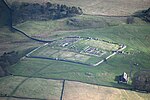Sycamore Gap tree

The Sycamore Gap tree or Robin Hood tree was a sycamore tree standing next to Hadrian's Wall near Crag Lough in Northumberland, England. It was located in a dramatic dip in the landscape, which was created by glacial meltwater and was a popular photographic subject, described as one of the most photographed trees in the country and an emblem for the North East of England. It derived its alternative name from featuring in a prominent scene in the 1991 film Robin Hood: Prince of Thieves. The tree won the 2016 England Tree of the Year award. It was felled in the early morning of 28 September 2023 in what Northumbria Police described as "an act of vandalism". The felling of the tree led to an outpouring of anger and sadness. Two men from Cumbria, aged 38 and 31, were arrested in October 2023 and charged in April 2024 with criminal damage both to the tree and to the adjacent Hadrian's Wall.
Excerpt from the Wikipedia article Sycamore Gap tree (License: CC BY-SA 3.0, Authors, Images).Sycamore Gap tree
Military Way,
Geographical coordinates (GPS) Address External links Nearby Places Show on map
Geographical coordinates (GPS)
| Latitude | Longitude |
|---|---|
| N 55.00356 ° | E -2.37387 ° |
Address
Robin Hood Tree (Sycamore Gap Tree)
Military Way
NE47 7AH
England, United Kingdom
Open on Google Maps









